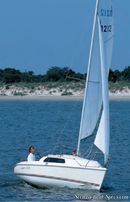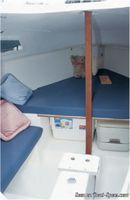Hunter 212
Sailboat specifications
The Hunter 212 is a 21’ (6.4m) cruising sailboat designed by Chuck Burns Yachts (United States). She was built between 1996 and 2002 by Marlow Hunter (United States).
Hunter 212's main features
- Model
- Hunter 212
- Hull type
- Monohull
- Category
- Coastal cruising sailboat
- Sailboat builder
- Sailboat designer
- Country
- United States
- Construction
- Thermoplastic:
Sandwich foam BASF Luran-S thermoplastic (outside skin) / glass fiber (inside skin) polyester - First built hull
- 1996
- Last built hull
- 2002
- Appendages
- Centerboard : pivoting centerboard
- Helm
- Single tiller
- Rudder
- Single transom hung rudder
- Unsinkable
- Yes
- Trailerable
- Yes
- Standard public price ex. VAT (indicative only)
- N/A €
Hunter 212's main dimensions
- Hull length
- 21’6.4 m
- Waterline length
- 18’5.49 m
- Beam (width)
- 8’ 2”2.49 m
- Draft
- 5’1.52 m
- Draft when appendages up
- 0’ 10”0.25 m
- Mast height from DWL
- 31’9.45 m
- Light displacement (MLC)
- 1801 lb817 kg
Hunter 212's rig and sails
- Upwind sail area
- 213 ft²19.79 m²
- Mainsail area
- 150 ft²13.94 m²
- Jib area
- 63 ft²5.85 m²
- Rigging type
- Sloop Marconi 7/8
- Mast configuration
- Deck stepped mast
- Rotating spars
- No
- Number of levels of spreaders
- 1
- Spreaders angle
- Swept-back
- Spars construction
- Aluminum spars
- Standing rigging
- 1x19 strand wire continuous
Hunter 212's performances
- Upwind sail area to displacementiThe ratio sail area to displacement is obtained by dividing the sail area by the boat's displaced volume to the power two-thirds.
The ratio sail area to displacement can be used to compare the relative sail plan of different sailboats no matter what their size.
Upwind: under 18 the ratio indicates a cruise oriented sailboat with limited performances especially in light wind, while over 25 it indicates a fast sailboat. - 244 ft²/T22.64 m²/T
- Displacement-length ratio (DLR)iThe Displacement Length Ratio (DLR) is a figure that points out the boat's weight compared to its waterline length. The DLR is obtained by dividing the boat's displacement in tons by the cube of one one-hundredth of the waterline length (in feet).
The DLR can be used to compare the relative mass of different sailboats no matter what their length:
a DLR less than 180 is indicative of a really light sailboat (race boat made for planning), while a DLR greater than 300 is indicative of a heavy cruising sailboat. - 140
- Critical hull speediAs a ship moves in the water, it creates standing waves that oppose its movement. This effect increases dramatically the resistance when the boat reaches a speed-length ratio (speed-length ratio is the ratio between the speed in knots and the square root of the waterline length in feet) of about 1.2 (corresponding to a Froude Number of 0.35) . This very sharp rise in resistance, between speed-length ratio of 1.2 to 1.5, is insurmountable for heavy sailboats and so becomes an apparent barrier. This leads to the concept of "hull speed".
The hull speed is obtained by multiplying the square root of the waterline length (in feet) by 1.34. - 5.69 knots
Hunter 212's auxiliary engine
- Engine(s)
- 1 outboard engine
Hunter 212's accommodations and layout
- Cockpit
- Open aft cockpit
- Berth(s) (min./max.)
- 2 / 4



Marlow Hunter Hunter 212 layout - - 2/4
Picture extracted from the commercial documentation © Marlow Hunter
Picture extracted from the commercial documentation © Marlow Hunter


Marlow Hunter Hunter 212 sailing - - 3/4
Picture extracted from the commercial documentation © Marlow Hunter
Picture extracted from the commercial documentation © Marlow Hunter


Marlow Hunter Hunter 212 interior and accommodations - - 4/4
Picture extracted from the commercial documentation © Marlow Hunter
Picture extracted from the commercial documentation © Marlow Hunter
Similar sailboats that may interest you:
Sailboats
First built hull
Hull length
1977
18’ 10”5.74 m
1995
21’ 6”6.55 m
1961
22’ 7”6.9 m
1985
22’ 7”6.9 m
2005
24’ 6”7.47 m
1994
16’ 7”5.05 m
1976
19’ 8”6 m
1993
20’6.1 m
1999
20’ 4”6.2 m
1970
21’ 8”6.6 m
1995
25’ 5”7.75 m
1995
22’ 6”6.85 m
1977
23’ 7”7.2 m
1978
21’ 6”6.55 m
1989
20’ 8”6.3 m